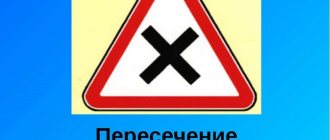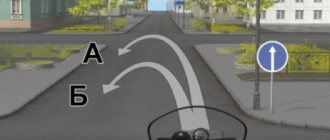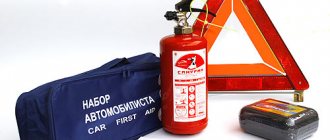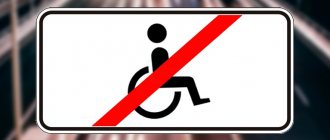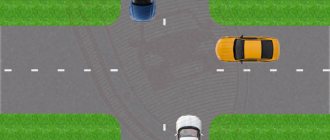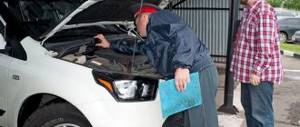The best remedy for violators
IN is an effective weapon against reckless drivers. If violators may not comply with the signs and markings, then it is impossible to ignore the impressive unevenness. The very first attempt to “fly” without braking will force you to learn the rules of the road for life. It will shake so much that it doesn’t seem like much, and maybe it will even end in expensive car repairs.
Even if you do not violate the speed limit, if you frequently drive incorrectly along the highway, you can damage your car's suspension or steering. This lies in the fact that many motorists depress the brake pedal when passing an obstacle. Thus, at the moment of collision of wheels and unevenness, the pressure increases to the maximum, which can lead to breakdown. The correct way to pass a speed bump is to coast or use light throttle. You need to brake in advance, before the obstacle, and then release the pedal and let the car ride along the “wave” on its own.
Bottom line
The main task of a speed bump at the place where it is installed is to limit the speed of vehicles.
It is worth noting that specially created INs on asphalt work very well, i.e. drivers reduce speed on them. Driving through these protrusions at high speeds, more than 40 km/h, will definitely be unsafe for the driver himself, and can also lead to damage to the car’s suspension. In this regard, the most recommended and optimal speed is 20 or 40 km/h.
Requirements for artificial bumps
In Russia, general technical requirements for artificial bumps for forced speed limiting of vehicles and the rules for their use are regulated by GOST R 52605-2006. The dimensions of the artificial bump depend on the maximum permitted speed. The standard provides for the application of markings and installation of signs in accordance with GOST R 52289, GOST R 52290 and GOST R 51256. To ensure visibility at night, retroreflective elements must be applied to the surface of the artificial unevenness. The installation of speed bumps is permitted only on sections of roads with artificial lighting and provided drainage from the roadway.
It should be noted that many artificial bumps on the roads do not meet GOST requirements and pose a danger to cars. The most common violations are deviations from the prescribed dimensions and lack of signs and markings.
3D speed bumps, which are increasingly appearing in different cities of Russia, comply with GOST. As Andrey Nazarenko, head of the traffic police department for the Nizhny Novgorod region, explained, there is hope that this will reduce the number of accidents, and to save human lives, the traffic police are ready to use various techniques, including drawings on the asphalt.
Designation "Artificial hump"
This sign with the number 1.17 “Artificial Roughness” is installed in accordance with the requirements of the State Standard in places with a large number of pedestrians.
The design and shape of the speed bump does not allow drivers to ignore it and drive as they were driving. In addition, modern road bumps are made of high-quality material, from which the paint does not come off so quickly, so the yellow color of the bump is clearly visible from afar.
Artificial humps must be installed near schools, and also, according to statistical analyses, where most accidents occur, accidents involving pedestrians: adults, children. Wherever there is a danger of the driver committing a dangerous action, for example, on turns, on dangerous roads, etc.
In populated areas, sign 1.17 “Artificial Roughness” is installed 50-100 meters away, and outside populated areas - 150-300 meters away. In addition to one sign 1.17, a sign indicating the distance, for example “300 m”, in this case, how long this obstacle will be, can be installed under it.
The initial bumps on the roads began to be made of asphalt. The unevenness was made without any special overall dimensions, a semicircle or semi-oval, the main thing was that the ascent and descent be smooth. But, some asphalt speed bumps are made steep, which creates a shock even when driving at low speed. Such “policemen” have to be moved very slowly. The asphalt unevenness is covered with 1.25 Zebra markings with paint or sticker.
An artificial hump can only be installed where there is lighting, otherwise it can, on the contrary, lead to an accident if the driver does not notice it in the dark. If, God forbid, an accident occurs and you do not agree with the assessment of the insurance company OSAGO or CASCO, then you can turn to independent experts after the accident.
A warning sign is installed in front of the speed bump itself, notifying that there will soon be a bump and you need to slow down. The warning sign is in a triangular shape and is red, white and black in color, while the “Human Speedway” sign itself is rectangular in shape and is white, blue and black in color.
Installation according to GOST
For 2021, the installation rules are regulated by the relevant GOST number R. 52605-2006, which specifies all the parameters of speed bumps and the rules for their installation.
Speed bumps come in two types - trapezoidal and wavy, and all their dimensions (height, length, etc.) are regulated by GOST. For example, with a speed limit sign set to “20”, the height of the wave-shaped speed bump will be no higher than 0.07 meters, and the length will be from three to three and a half meters.
Thanks for subscribing!
Let's look at the most important points regarding the installation of a speed bump:
- A speed bump must be accompanied by a corresponding road sign, as well as markings that will warn motorists that they are approaching an obstacle;
- Drainage equipment during installation;
- The size of the unevenness must be no less than the width of the road. The permitted deviation is up to twenty centimeters on each side;
- Speed bumps can only be installed on paved and well-lit roads.
In a situation where one of the installation rules was violated or when the recommended value of the speed bump parameters was exceeded, you need to file a complaint with the traffic police.
Signs in front of speed bumps
1.17 and 5.20 are usually used together in the same hazardous area. The first warns the driver in advance that he will soon find himself on a road with a specially created hill. 5.20 in the traffic rules is described as follows:
Artificial hump." Indicates the boundaries of an artificial roughness.
That is, it is fixed directly in front of the mound.
There are often other signs in front of a speed bump:
- plate 8.1.1 indicating the distance to the unevenness (installed from 1.17);
- 3.24, which requires drivers to limit their speed to a certain value;
- 5.19.1 and 5.19.2 outlining the boundaries of the pedestrian crossing (next to 5.20);
- 1.22, indicating that in a few meters there will be a zebra crossing (directly from 1.17).
Less often you can see 1.17 next to symbols indicating the significance of the territory where the car is entering, or signs of nearby objects. This is, for example, 5.21, installed at the beginning of a residential area, or 6.4 (in front of the parking lot), etc.
Where is it prohibited to place an ID?
In some situations, installing unevenness can cause severe inconvenience, or even provoke an accident.
Here are the places where there can be no artificial obstacles:
- Federal highways;
- Regional multi-lane (4 or more) roads. At the same time, in areas that pass through populated areas, installation of IN is permitted;
- Highways;
- Bus stops and nearby lanes;
- Trolleybus routes;
- Bridges, the area under them, tunnels, overpasses, overpasses;
- The territory within a radius of one hundred meters near the railway crossing;
- Any routes to hospitals and first aid stations, fire stations, gas services and other areas where emergency response teams are located;
- Locations of underground communications with inspection wells reaching the surface.
Advantages of rubber IDNs compared to polymer sand ones
| Rubber | Polymer sand |
| 1. Selection of a high-quality rubber formulation specifically for the production of a product that meets GOST standards. Quality control of raw materials is carried out according to various indicators. | 1. The production of polymer sand products begins with the purchase of recyclable materials, which are waste from a variety of polymer products. The quality of raw materials remains uncontrolled. |
| 2. The product sample is pressed and its geometry is monitored by the technical control department. This stage is mandatory. The products comply with GOST R 52605-2006. | 2. At the second stage, recyclable materials are crushed, resulting in the formation of a mass of fine fractions resembling sand. Raw materials require repeated cleaning; if the product is cheap, then the technology is not followed, because the cleaning process is an expensive procedure. |
| 3. Production of the main batch of IDN. Gluing of products with reflective elements is carried out using a special adhesive composition for greater strength. Due to the elasticity of the material, the product can be installed both on a flat surface and on an object with uneven surfaces. Today, rubber IDNs are the most modern and wear-resistant in the industrial sector. The production of IDN is carried out on the basis of both natural and synthetic types of rubber. | 3. Adding sand (up to 80% of the mixture), coloring pigment and mixing the mixture. Next comes pressing of the product. Sometimes manufacturers add a lot of sand to the product, which negatively affects the strength of the product. In addition, these products can only be installed on a perfectly flat surface, otherwise it may crack already at the installation stage. Due to the lack of control, the manufacturer can save at any stage of production unnoticed by the consumer, which affects the quality of the finished product. |
What is stated in GOST
- The “speed bump” can be either a prefabricated structure or a monolithic one, that is, it can be a raised platform made of the same material as the road surface itself.
- Its maximum height should be 7 cm.
- An artificial hump must be accompanied by a speed bump sign installed on both sides of the road.
- Plus, it must be accompanied by markings that the driver could see from afar.
- In those places where an artificial road roughness (abbreviated as IDN) is installed, drainage systems must be organized to prevent the formation of puddles and accidents during sudden braking.
- On one section of the road the maximum number of speed bumps is 5.
- It is prohibited to place them on federal highways, expressways, bridges, in tunnels and near bus/trolleybus stops. This list also includes entrances to emergency services buildings, such as ambulance stations, hospitals and fire stations.
Of course, no one often adheres to so many rigid positions. After all, a certified “police officer” installed in accordance with all the rules will cost about 30 thousand rubles. Not every administration is ready to allocate them from the local budget.
On certain sections of roads there is a need to install artificial humps, which are designed to encourage motorists to slow down and prevent the occurrence of dangerous and emergency situations, as a rule, in front of socially important objects that are equipped with a pedestrian crossing - these are schools, hospitals, kindergartens and other public and social infrastructure facilities. To warn the driver about this obstacle, it is necessary to install a road sign “Artificial hump” 5.20 in front of it.
This sign is prescriptive and indicates to drivers the boundary of the section of the roadway on which a speed bump is installed. The sign is most often used together with another sign - 3.24, which recommends reducing the speed limit to the specified value. In addition, areas in front of which sign 5.20 is mounted are equipped with a special type of road marking 1.25. This marking is a transverse stripe with a white and black checker, which is applied one directly to the unevenness, or two on both sides of the artificial unevenness.
There is a warning road sign “Artificial hump” 1.17. If such a sign is located in a populated area, then it is installed 50 - 100 m before the equipped crossing. If such a crossing for pedestrians is installed outside a populated area where a different speed limit is prescribed, the sign is installed at a distance of 150 - 300 m.
When installing road bumps, both prefabricated and monolithic, there are general rules. First of all, the height of the structure is regulated - it can protrude no more than seven centimeters above the road surface. The IND is installed in such a way that motorists cannot bypass it, i.e. the entire width of the road.
The legislation also regulates the mandatory installation locations of IDN. These include those sections of the road through which heavily trafficked pedestrian paths pass:
- 10-15 m before the start of the transition in front of general education and specialized children's institutions, train stations, crowded places, sports institutions, exhibitions, in parking lots, in places with large concentrations of pedestrians, passages, hypermarkets, etc.
– in front of sections of roads with limited visibility, in front of emergency areas;
– in front of the territory “Residential zone.
Road signs “IND” or “Speed Bumps”, both warning and mandatory, are prohibited from being installed in cases specified by law:
– on highways that are of federal importance;
– on highways with single-lane traffic (4 or more lanes) of local importance, with the exception of sections that cross villages with a population of more than a thousand people;
– in front of the access roads of hospitals, departments of the Ministry of Emergency Situations, parking lots of special motor transport enterprises, ambulance stations, emergency services;
– on bridges, overpasses, overpasses and tunnels;
– near railway tracks and crossings at a distance of at least 100 m in both directions;
– above the hatches of inspection wells of utilities, collectors, cable
channels.
Road signs are installed in accordance with the provisions of the “Road Rules”, guided by the requirements of modern urban planning and considerations of organizing the safe movement of motorists and pedestrians in conditions of busy city traffic.
Speed bump artificial road hump
A speed bump is a bump (artificially created) that is installed on the road in order to limit the speed of traffic in a given area.
Artificial bumps (which you can buy right now) are used in the following places: near hospitals, schools, kindergartens; nearby pedestrian crossings; at automobile gas stations, in the area of logistics centers and parking lots; in front of entrances to various enterprises and barriers; near public buildings and so on.
Crosswalk
The sign warns the driver that a pedestrian crossing will soon appear on the road:
Naturally, the boundaries of a pedestrian crossing must be marked with an appropriate special regulations sign or appropriate road markings.
Please note that overtaking vehicles is prohibited at the pedestrian crossing. Therefore, if you come across sign 1.22, then try to complete the overtaking you have started before the pedestrian crossing or stop the maneuver in a timely manner.
How to give way to a pedestrian?
How to install IDN
In the situation with concrete limiters, there are not many subtleties of installation:
- The asphalt, which will be uneven, is washed and cleaned of dust, dirt and puddles. Sometimes its top layer is cut off for better adhesion to the solution;
- In some cases, road workers use a form to pour concrete, but more often they create a “speed bump” without special restraints;
- The new road object is given time to harden, after which special markings are applied and warning signs are placed.
The collapsible structure is also easy to install, but you need to know the basic requirements:
- The surface of the roadway at the site of future installation must be smooth, without potholes or pits;
- Before installation, you need to ensure the quality of the asphalt and check its thickness. Based on this information, mounting bolts are selected;
- Next, the design of the IN itself is compiled. The parts must be tightly connected to each other without joints or gaps;
- The number of elements used depends on the width of the road. Clearances on the sides should not be more than 20 cm - such a loophole will allow drivers to go around the obstacle on one side of the car. This will lead to incorrect distribution of the load on the IN and, as a result, its breakdown;
- Before installation, the points of future holes for fastenings are marked and drilled with a special tool;
- The speed bump is placed in the designated place and screwed with special anchor bolts. The fasteners must be fully tightened;
- During installation, be sure to use all fasteners;
- Only specialized organizations that have the right of access to such work and the necessary licenses and permits have the right to carry out work on installing ID.
There is nothing complicated about installing speed bumps. Any qualified team will quickly cope with this matter. It is a little more difficult to obtain permission to place such an object, but if you are absolutely sure that it is necessary, submit an application and prove your point of view.
But you should not make limiters without permission from the administration or the traffic police - they can be dismantled without warning and a fine will be issued for illegal installation of the object. And in this case, no one will return the money spent on installation. Act legally and the speed bump will protect you for many years.
To shorten the journey or avoid a traffic jam, car drivers often drive through internal driveways without reducing their speed. Thus, a speed bump in the yard is a pressing issue for many residents of large cities.
The main mistakes when driving over speed bumps
In fact, we are talking about an artificial elevation, one might say, a man-made obstacle on the roadway, forcing drivers to slow down. The unusual term, by the way, came from England, and initially the bumps and bulges on the asphalt were called “sleeping policemen.”
The principle of operation of such restrictions is the inevitable punishment of “reckless drivers” who do not slow down in front of “recumbents”. It is no secret that shocks lead to the gradual failure of various suspension components: struts, ball joints, wheel bearings, tie rod ends.
What types of speed bumps are there?
Photo: Evgeny Biyatov/RIA Novosti
On the streets of large cities today, the most common are “speed bumps” made in accordance with GOST (GOST R 52605-2006). According to it, artificial obstacles can be of two types: monolithic from asphalt concrete and prefabricated from high-strength rubber and polymer materials.
In this case, as a rule, rubberized and plastic structures are attached to the asphalt with bolts. The dimensions of the artificial bump depend on the maximum permitted speed. It is important that the installation of speed bumps is permitted only on sections of roads with artificial lighting and ensured drainage from the roadway. The section of roads where a speed bump is installed must contain warning sign 1.17 “Artificial Roughness”, as well as road markings “checkerboard squares”.
But nevertheless, many artificial bumps on the roads, alas, do not meet the requirements of GOST and pose a danger to cars and riders. On the roads of our country you can easily find man-made asphalt “navels” of bizarre shape or flatter asphalt waves (on higher-speed sections), as well as homemade structures made from used tires and plastic supporting structures. Sometimes, instead of real speed bumps, 3D drawings are used on a flat surface, creating a visual sensation of the presence of unevenness.
Errors when driving speed bumps
Photo: Victor Tolochko/TASS
One of the most common mistakes is driving over a speed bump without slowing down. Drivers who use this maneuver act on the principle of “higher speed - fewer holes and bumps.” Unfortunately, this practice is fraught with serious damage to the chassis and even injuries to the driver and passengers. Their spines will definitely not say “thank you” to such a driver.
An equally common mistake is driving over a speed bump with the brake pedal depressed. In this case, the suspension is loaded and the impacts on the chassis elements will be much more serious than with an unloaded suspension. You need to do just the opposite - either brake smoothly in advance, or briefly hit the brake pedal just before the obstacle. In the latter case, you will overcome the “recumbent” with an unloaded, in other words, relaxed suspension, minimizing the impact force.
It happens that drivers cheat and let only the wheels of one side go over the “recumbent”, shifting the car partially to the side of the road. Firstly, because of such wobbling, you can run into a fine (driving on the side of the road), and secondly, this method does not relieve the load on the suspension. Moreover, the chassis elements on the side of the speed bump are subjected to even greater load. Finally, you can also scratch your rims on the curb.
How to move over obstacles correctly
Photo: iStock
The most correct practice is to slow down in advance before an obstacle. It should be passed smoothly, at low speed. An alternative is the method described above with suspension unloading. There is also such good advice - drive over speed bumps at an angle to it.
In this case, the wheels take turns moving over the obstacle, and the load on the chassis is minimized. Just make sure that with this method there is no interference in the form of pedestrians or neighboring cars.
What to do with “lying down” people not according to GOST
Photo: Dmitry Rogulin/TASS
What should you do if you encounter a homemade “hump” made of asphalt or plastic along the way? It all depends on the specific configuration of the obstacle.
Extremely high bumps should be crossed with great caution, slowing down to the minimum speed, and it is better not to use the method of crossing such an obstacle diagonally - cars with low ground clearance have a chance to hit the obstacle with the threshold.
It also happens that a plastic “lying down” with fragments torn out of the asphalt appears on the way. Here the main advice is the following - you should not direct any of the wheels into the resulting depression, trying to minimize the rocking. The fact is that bolts and fittings can stick out from the asphalt, and you can easily puncture a tire. It would be much wiser to drive a recumbent, leaving a gap between the wheels.
What to do if you damage your car while driving over a speed bump? If there is a chance to get compensation through the court. To do this, you need to find evidence that the “recumbent” was not installed in accordance with GOST. If it is a plastic prefabricated structure, check that all its elements are in place. Otherwise, take photos of problem areas and damage to your car.
The structure must also have reflective elements, and the location of the obstacle itself is indicated by road signs. Didn't find the above conditions? Your chances of winning the case have increased dramatically.
For concrete and asphalt structures, check for subsidence, potholes, and other damage. “Record” possible flaws. And finally, know that traffic police officers monitor the condition of speed bumps. Therefore, in case of possible problems when driving through such obstacles, you should simply call the squad - as in the case of a regular accident.
5 dangerous mistakes when changing and adding engine oil:
What it is
A “sleeper” or “speed bump” is an artificial elevation on the road surface. Its direct purpose is to force drivers to slow down. Such structures are installed in potentially dangerous areas, for example, at sharp turns, near schools and playgrounds, at the entrance to supermarkets, etc.
Abroad, “police” ones are made of a thick layer of rubber (as a rule, used tires are used) with a cast iron base. Such structures are portable and mobile. In our country, as a rule, this is a pile of concrete poured across the road. The height and steepness of the embankment depend on the degree of potential danger in the area.
Installation of speed bumps and other signs, mirrors
Triangular
Dimensions Height: 700 mm Width: 700 mm Material: galvanized metal 0.8 mm thick
Price: from 599 rub.
Round
Dimensions Diameter: 600 mm Film type: A (commercial) Material: galvanized metal 0.8 mm thick
Price: from 799 rub.
Square
Dimensions Height: 600 mm Width: 600 mm Material: galvanized metal 0.8 mm thick
Price: from 799 rub.
Octagonal
Dimensions Diameter: 700 mm Film type: A (commercial) Material: galvanized metal 0.8 mm thick
Price: from 855 rub.
Special instructions
Dimensions Width: 700 mm Height: 1050 mm Material: galvanized metal 0.8 mm thick
Advantages of our production IDN
Wear-resistant and durable rubber
Our speed bumps are made using high quality rubber that does not contain any waste.
Robust design
The parts of the artificial road roughness are fastened together with a tongue-and-groove type lock. This connection of the product elements is strong and reliable, it gives the product the necessary solidity.
Reliable glue
The special adhesive composition used in the production of our speed bumps firmly adheres the reflective film to the surface of road irregularities.
3M reflective elements
Reflective stripes on the surface of the product make our IDNs clearly visible in low light conditions. Retroreflective elements manufactured by ZM have optimal reliability and durability. The light reflection area of our IDNs exceeds GOST requirements by 2 times.
High reliability of fastenings
Special metal discs that reinforce the mounting holes in the products ensure reliable fastening of speed bumps to the road surface. Such metal disks are welded into the IDN body during the vulcanization process of the product. This prevents speed bumps from being pulled out of the road surface during their operation.
Minimum voids
There are practically no voids or cavities at the base of our IDNs. This ensures optimal rigidity of the equipment and reduces the rate of its destruction. When creating road bumps, we do not skimp on consumables. Thus, the weight of the IDN-500 from the Tekhnologiya PC is 14 kg, and the IDN-900 is 24 kg.
Speed bump
This is directly reflected in the attractive cost of products, which you can verify by calling us on a single toll-free number. Work with us and you will experience clear benefits from the first day of cooperation!
Our company's assortment includes various models of speed bumps - you can always buy these items in Moscow at a low cost. All products and components for installation are in stock. The weight of the middle element is 23 kg, the end element is 4 kg.
The weight of the middle element is 13 kg, the end element is 3 kg.
The weight of the middle element is 8 kg, the end element is 4 kg.
Public roads.
Entrances to areas designated as “Residential Areas”. Private and internal areas, courtyards.
Rules for installing collapsible speed bumps
This design consists of several identical main and edge parts.
- The elements are assembled from one or a pair of plates connected together by machined grooves. They must have special holes for reliable bolting to the road surface.
- The structures should be easy to install and dismantle. Its individual parts must be easily changed, if necessary.
- The maximum height of the elements ranges from 5 to 6 centimeters, and the length of the IN is calculated from the maximum permitted speed.
- The composition of the IDN should be strong, but elastic. A high coefficient of adhesion to the surface is required.
- It is mandatory to apply reflective elements in the direction of transport to ensure visibility of the vehicle at night.
- If some parts are missing or installation parts protrude, operating the IN is dangerous for drivers and is unacceptable. This may damage your car tires.
- When dismantling the vehicle, all fasteners should be removed, holes in the road should be sealed, and traffic signs and markings should be removed.
Acceptable size table
GOST contains information on the requirements for the design features of both monolithic and prefabricated speed bumps.
Asphalt concrete
| Limit speed, km/h | Length | Maximum height | Radius of curved surface |
| 20 | from 3.0 to 3.5 | 0,07 | from 11 to 15 |
| 30 | from 4.0 to 4.5 | 0,07 | from 20 to 25 |
| 40 | from 6.25 to 6.75 | 0,07 | from 48 to 57 |
Collapsible
| Limit speed, km/h | Horizontal length | Maximum height |
| 30 | From 0.50 to 0.70 | From 0.05 to 0.06 |
| 40 | From 0.90 to 1.10 | From 0.05 to 0.06 |
According to reviews from experienced motorists, these standards are not always observed, especially when constructing monolithic barriers.
Special markup 1.25
Such markings are rather an additional warning and a pointer to the boundaries of the speed bump. When driving through such a section, you should slow down significantly in order to spare the suspension, as well as the wheels of your car.
The traffic rules provide for the installation of another sign that informs vehicle drivers about approaching an area equipped with a speed bump. This warning road sign is made in the form of a triangle and has the designation 1.17 in the traffic rules.
Despite certain similarities, however, these two signs should not be confused. Sign 1.17 is a warning sign and informs drivers about approaching a specially created obstacle, which is located across the road after 50-100 m - for a populated area or 150-300 m - outside a populated area. Road sign “Artificial hump” 5.20 is, in turn, a sign of a special requirement and is installed directly at the obstacle itself.
More about the sign
With the advent of the possibility of erecting artificial obstacles, new road signs appeared in the traffic rules:
- 1.17 “Artificial hump” with a red border, the purpose of which is to warn about the imminent appearance of an obstacle;
- 5.20 “Artificial hump” with a blue border, indicating the location of the IDN.
It is important to understand that temporary or permanent structures on the road should not come as a surprise to the car owner, because... Driving speed bumps at high speed can result in damage to the suspension and subsequent repairs.
GOST requirements when installing ID
When installing signs and markings about irregularities, as well as the undulating surface on the road, the requirements of GOST must be observed.
When installing the IN, the following mandatory conditions must be met:
- Reflective stickers must be clearly visible to drivers on each side when passing, and the area of application of which, according to GOST, must be at least 15% of the total area of the artificial bump;
- The speed bump must be installed across the entire width of the road and perpendicular to its edges. The error from the edges is allowed no more than 20 cm on each side;
- The type of speed bump can be of two types: wavy or trapezoidal, the height of which in any case should not exceed 7 cm;
- IN can only be installed on asphalt or concrete road surfaces;
- When installing speed bumps, artificial lighting must be created for good visibility.
The main task of a speed bump at the place where it is installed is to limit the speed of vehicles.
It is worth noting that specially created INs on asphalt work very well, i.e. drivers reduce speed on them. Driving through these protrusions at high speeds, more than 40 km/h, will definitely be unsafe for the driver himself, and can also lead to damage to the car’s suspension. In this regard, the most recommended and optimal speed is 20 or 40 km/h.
Forced speed reduction element (speed bump)
(from English
sleeping policeman
) - the term came from England and was originally called “sleeping policeman.”
For the first time, artificial road humps (ARH) or speed bumps began to be used in the United States at the beginning of the 20th century to forcibly limit the speed of vehicles on dangerous sections of roads.
At that time, the United States was experiencing rapid and massive motorization, and the owners of farms, past which highways passed, were very concerned about the safety of livestock, which often ended up under the wheels of passing cars.
Most often installed in residential areas or near pedestrian crossings, etc.
The principle of operation is that when crossing a speed bump at high speed, the car's suspension shakes. Such shocks lead to the gradual failure of various vehicle components: struts, ball joints, wheel bearings, tie rod ends and others. In order not to delay the next repair, drivers are forced not to exceed the speed limit.
The new generation of speed bumps are made from used tires and have a plastic structure running through them.
Also, the latest versions are equipped with an anti-icing system. In winter, it is recommended to dismantle it for efficient operation of snow removal equipment.
GOST for installation
It is prohibited to create artificial obstacles on the roadway just anyhow and anywhere. Therefore, there is a special GOST, rules by which it must be installed, whether it is homemade from asphalt or a purchased special unevenness.
Requirements for speed bumps:
- The surface must have reflective stickers that are clearly visible to drivers on both sides of the roadway. The decals must cover at least 15% of the entire speed bump area.
- It is allowed to install only on the entire width of the roadway. The unevenness should be perpendicular (90 degrees) to the sides of the road. The permissible deviation from the perpendicular line is no more than 20 centimeters on each side.
- The shape of a speed bump can be trapezoidal or wavy. The height of the waves or trapezoid should not be more than 7 cm.
- Speed bumps can only be installed on asphalt or concrete surfaces. It cannot be installed on a dirt or crushed stone road.
- In places where the IN is installed, lighting should be installed for visibility at night.
Procedure for installing a speed bump
The installation of speed bumps is organized by separate services of local governments, whose specialists annually draw up a plan for the order of their installation. First of all, it is necessary to find out whether it is planned to install an artificial roughness in the required location according to the approved schedule.
If the installation of a speed bump in a particular yard is not included in the plans of the municipal authorities, the residents of the yard can submit a collective application. During the application process, the maximum possible number of signatures is collected, after which the document is submitted for consideration to the local administration. Also attached to the application are the locations of the proposed installation of the structure with photographs.
If the verdict is positive, the installation of the speed bump will be carried out at the expense of the municipal treasury. It should be borne in mind that the time from consideration of the application to the installation of the road structure may take a long period. When considering applications, preference is given to places located near medical and educational institutions.
If funds are available, the initiative group can independently purchase the necessary equipment. In addition to the speed bump design itself, it includes a set of road signs required for installation by traffic regulations.
With any source of financing for the purchase and installation of a speed bump, its installation must be approved by the traffic police. If this stage is ignored, the structure can be dismantled legally.
Very often, in places where various socially significant objects are located - preschool institutions, schools, hospitals, and so on, an artificial hump, the so-called speed bump, is specially installed across the direction of traffic flow immediately in front of the pedestrian crossing.
The Vienna Convention in 1968 adopted a unified system of road signs valid throughout the world. This allowed a driver who arrived in a foreign country to navigate the road without even knowing the language. However, unlike Western cities, a sign indicating an artificial hump appeared on Russian streets only in 2006. The speed bump itself is designed to maintain the established speed limit for vehicles on a specific section of the roadway.
When did the speed bump appear?
When the speed bump appeared:
- The device first appeared in the USA at the beginning of the 20th century. Farmers began making embankments because they were concerned about the safety of their livestock. During this period, cars became widespread, almost every resident of America got an iron horse, and accordingly, there were more accidents on the roads due to non-compliance with the set speed and a large number of cars.
- Farmers were forced to cover the road with crushed stone or clay, creating artificial elevations in order to force the car to stop. In modern conditions, such embankments are mainly created in places where there is a pedestrian crossing or a large number of dangerous elements on the road.
They are often installed near schools, kindergartens, and in places where children often live. The motorist is forced to stop so as not to destroy his car. If you pass a speed bump at high speed, the suspension and important components of the car shake. This brings scheduled repairs closer, worsens the performance of the car, and affects its performance. Thus, motorists who ignore speed bumps are more likely to have to repair their car.
Unevenness
Preface
The goals and principles of standardization in the Russian Federation are established by Federal Law of December 27, 2002 N9 184-FZ “On Technical Regulation”, and the rules for applying national standards of the Russian Federation are GOST R1.0-2004 “Standardization in the Russian Federation. General provisions"
Standard information
1 DEVELOPED by the Federal State Unitary Enterprise "ROSDORNII" (FSUE "ROSDORNII") by order of the Federal Road Agency
2 INTRODUCED by the Technical Committee for Standardization TK 278 “Road Safety” and the Technical Committee for Standardization TK418 “Road Facilities”
3 APPROVED AND 8PUT INTO EFFECT by Order of the Federal Agency for Technical Regulation and Metrology dated December 11, 2006 N9 295-st
4 INTRODUCED FOR THE FIRST TIME
Information about changes to this standard is published in the annually published information index “National Standards”, and the text of changes and amendments is published in the monthly published information index “National Standards”. In case of revision (replacement) or cancellation of this standard, the corresponding notice will be published in the monthly published information index “National Standards”. Relevant information. notification and texts are also posted in the public information system - on the official website of the Federal Agency for Technical Regulation and Metrology on the Internet
Standardinform. 2007
This standard cannot be fully or partially reproduced, replicated or distributed as an official publication without permission from the Federal Agency for Technical Regulation and Metrology
fl
GOST R 52605-2006
Rules for installing monolithic IDN
- The structures are made only from asphalt concrete. In cross section they can be wavy and trapezoidal.
- The type of longitudinal profile depends on the presence or absence of rainwater wells on the descent at the IN. If there is no drain, the edges of the profile are cut off near the curb stone. This is done so that the water does not stagnate and flows along the road.
- The length of the speed bump depends on the speed limit in that area, but the maximum height is always the same. It cannot exceed 0.07 meters.
- Installation of asphalt concrete unevenness is possible only in places where there is good lighting.
What does a speed bump look like and its types?
The symbol itself has a different name, “speed bump” - this is a common, unofficial name. Even more often, this is the name given to an artificially created elevation on the roadway, forcing drivers to slow down.
What a speed bump sign looks like depends on what type of speed bump it is. After all, there are two such pointers:
- Belonging to the warning group 1.17 . It is an equilateral triangle with a red border and a white background with a black hump on it.
- 5.20, included in the group of special regulations indicators. It is a blue square with a white triangle inscribed in it. And in its center there is the same artificial bump as on the previous symbol.
The need for both designations is due to the fact that they are installed at different distances from the elevation on the roadway.
We recommend reading about road markings according to traffic regulations. From the article you will learn about the types of markings and their purpose, and what the driver should do if the markings are not visible. Find out more about the meaning of warning signs here.
